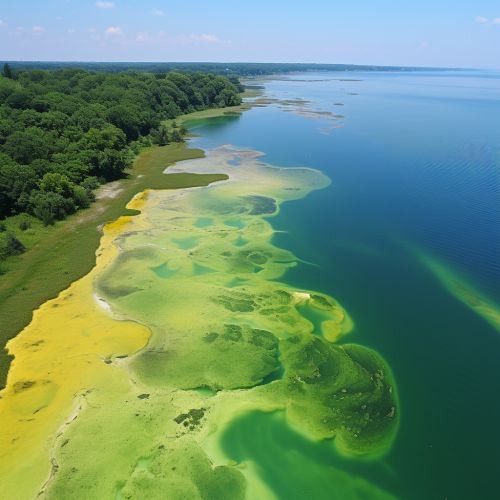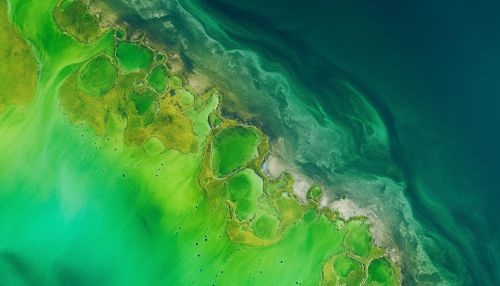Eutrophication
Overview
Eutrophication is a process driven by the enrichment of water by nutrient salts that causes structural changes to the ecosystem such as increased production of algae and aquatic plants, depletion of fish species, general deterioration of water quality and other effects that reduce and preclude use. This process can be natural or induced by human activity.
Causes
Eutrophication occurs when the environment becomes enriched with nutrients, leading to an increase in plant and algae growth. This can be a result of a number of factors, including natural processes such as weathering of rocks and the decomposition of plants and animals, as well as human activities such as agriculture, urbanization, and industrialization.
Natural Eutrophication
Natural eutrophication is a slow and gradual process that occurs over centuries or millennia as lakes and water bodies age and are gradually filled in with sediments and organic matter. During this process, the water body gradually becomes more fertile and rich in nutrients, leading to an increase in plant and algae growth.
Human-Induced Eutrophication
Human-induced eutrophication, also known as cultural or anthropogenic eutrophication, is caused by human activity that increases the amount of nutrients in a water body. This can occur through a variety of means, including the discharge of nutrients from sewage and industrial waste, runoff from agricultural fields, and the burning of fossil fuels.
Effects
The effects of eutrophication are diverse and can have significant impacts on aquatic ecosystems and human societies. These effects can include a decrease in biodiversity, changes in species composition, alterations in food web structure, and impacts on human health and economy.
Decrease in Biodiversity
One of the primary effects of eutrophication is a decrease in biodiversity. This occurs as the increased growth of plants and algae leads to a decrease in the amount of oxygen available in the water, leading to the death of other species.
Changes in Species Composition
Eutrophication can also lead to changes in the species composition of aquatic ecosystems. This can occur as certain species are able to take advantage of the increased nutrient levels and outcompete other species.
Alterations in Food Web Structure
The changes in species composition can also lead to alterations in the food web structure of the ecosystem. This can have significant impacts on the functioning of the ecosystem and can lead to further decreases in biodiversity.
Impacts on Human Health and Economy
Eutrophication can also have significant impacts on human health and the economy. The growth of harmful algal blooms can lead to the production of toxins that can be harmful to humans and animals. Additionally, the decrease in water quality can have significant economic impacts, including costs associated with water treatment and loss of revenue from fishing and tourism.
Prevention and Control
Preventing and controlling eutrophication is a complex task that requires a multifaceted approach. This can include measures to reduce nutrient inputs, restore damaged ecosystems, and manage water resources effectively.
Reducing Nutrient Inputs
One of the primary ways to prevent and control eutrophication is to reduce the amount of nutrients entering water bodies. This can be achieved through a variety of means, including improving wastewater treatment, implementing best management practices in agriculture, and reducing the use of fossil fuels.
Restoring Damaged Ecosystems
Restoring damaged ecosystems can also be an effective way to control eutrophication. This can include measures such as the reintroduction of native species, the removal of invasive species, and the restoration of natural water flow patterns.
Managing Water Resources Effectively
Effective management of water resources can also help to prevent and control eutrophication. This can include measures such as the implementation of water conservation strategies, the regulation of water use, and the development of integrated water resources management plans.


